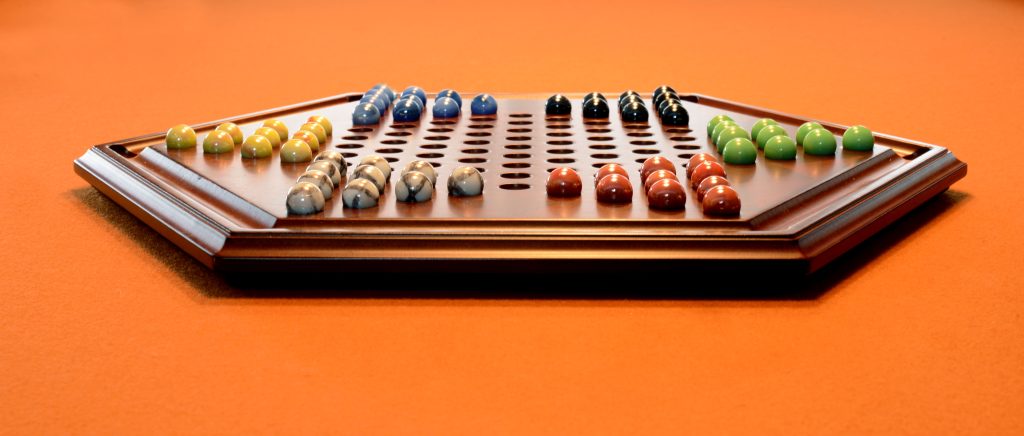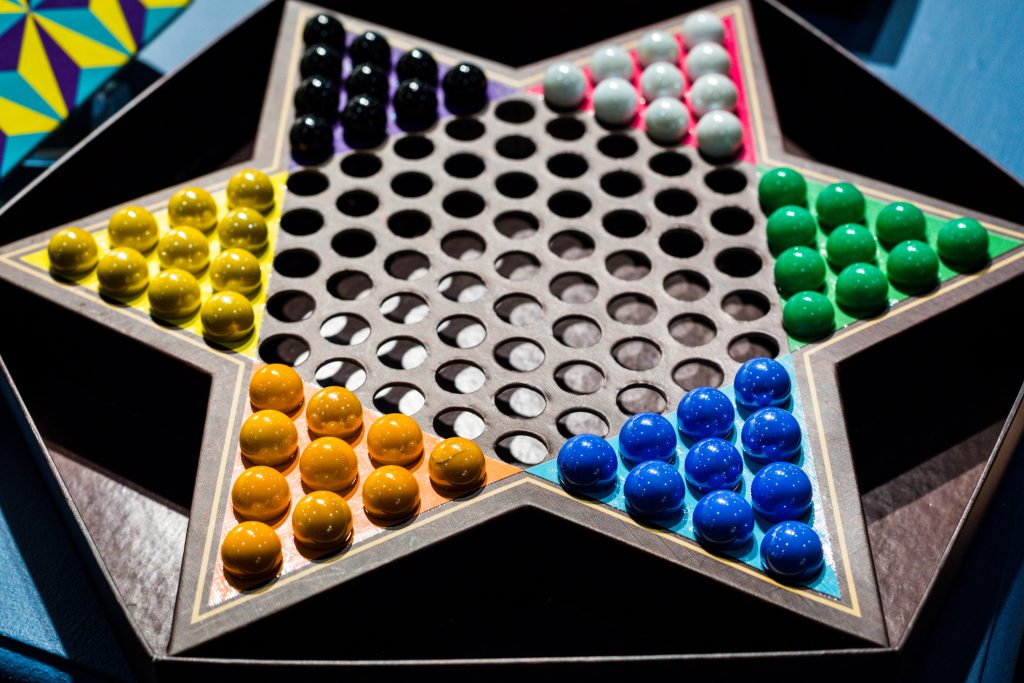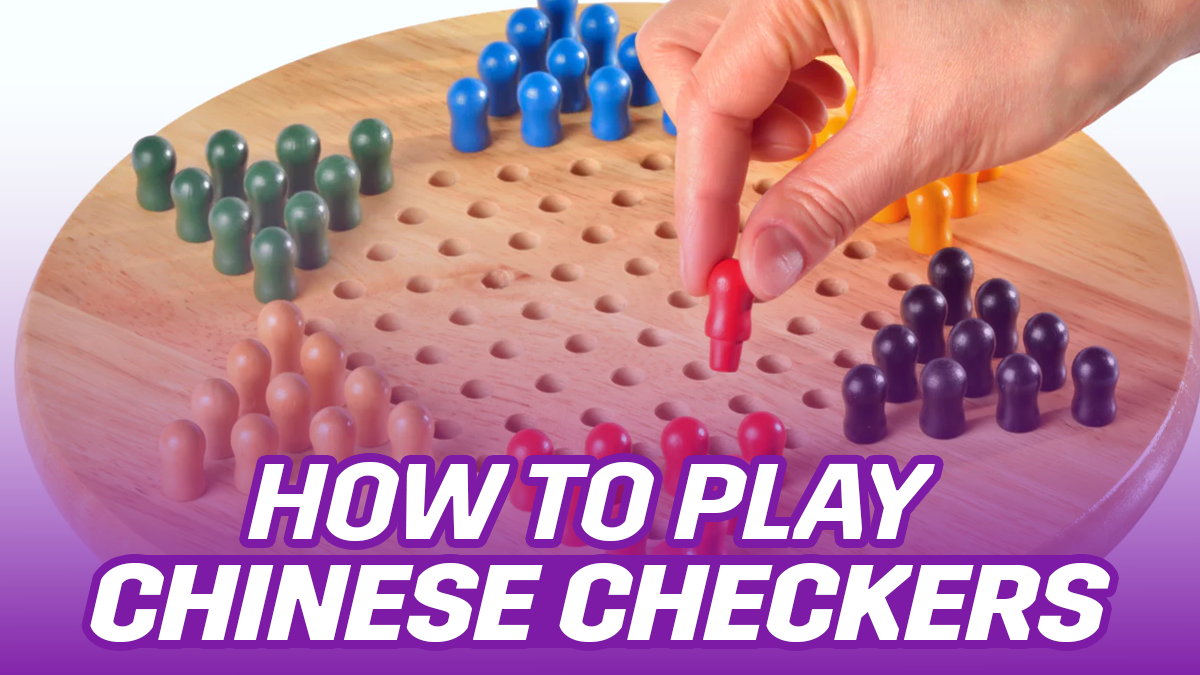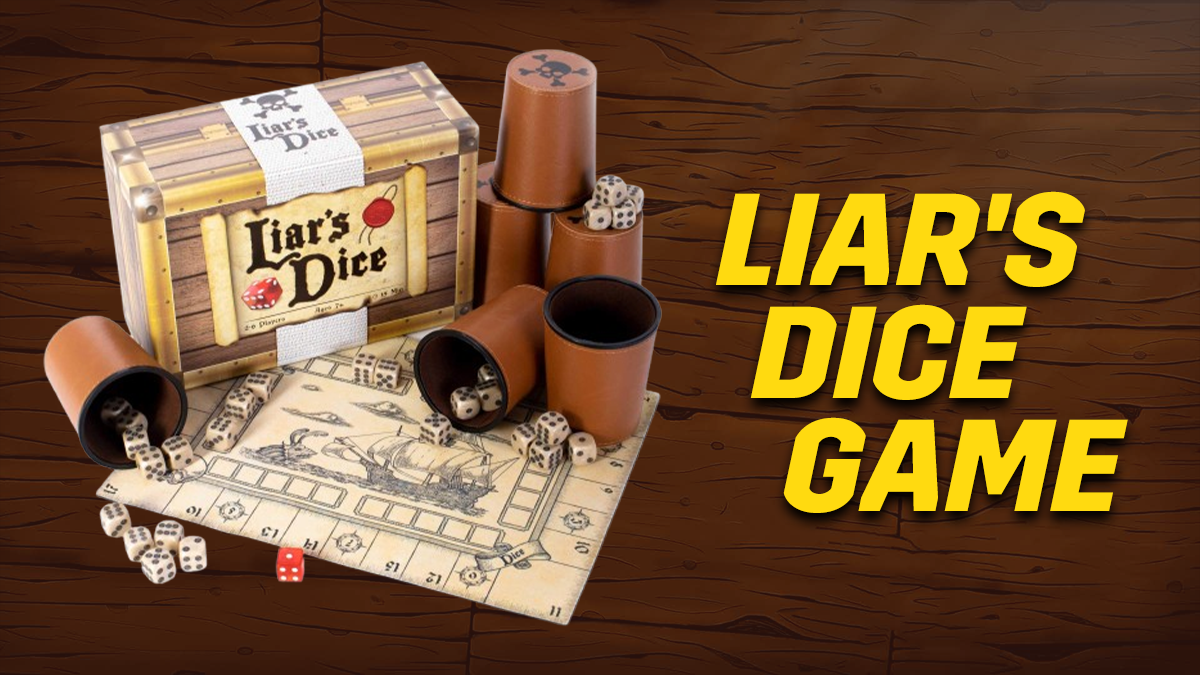Table of Contents
ToggleThe game of Chinese Checkers is a classic board game that blends strategy and competition with simple gameplay mechanics. Played on a star-shaped board, it involves moving beads strategically to reach the opposite corner before your opponents.
Despite its name, Chinese Checkers is neither related to traditional checkers nor did it originate in China. The game was invented in Germany in 1892 as Stern-Halma and was later rebranded in the United States in 1928 to make it more appealing. With a mix of skill, planning, and quick decision-making, Chinese Checkers is enjoyable for players of all ages.
Whether playing casually with friends or engaging in competitive play, understanding the rules of Chinese Checkers and learning advanced strategies can greatly enhance your experience. Let’s dive into the details of how to play Chinese Checkers game and master this timeless game.
What is the Chinese Checkers Board Game?

Source: Jpiks /shutterstock
The Chinese Checkers board game is a strategic, fun-filled game played on a star-shaped board with 121 points. Each player starts with 10 beads of the same color placed on one arm of the star. The objective is to move all your beads to the opposite corner before your opponents do.
Players can move one bead per turn, either by stepping into an adjacent space or by jumping over another bead. Despite its name, Chinese Checkers is neither related to checkers nor is it of Chinese origin; it was invented in Germany in 1892 and later marketed in the U.S. in 1928.
Facts of Chinese Checkers Game
- Chinese Checkers is played with 2 to 6 players at a time.
- The average game of Chinese Checkers takes around 10 to 20 minutes approximately.
- It is a strategy-based board game suitable for children above the age of 7 years.
Want to Master This Classic Board Game? Check Out the Official Mancala Guide by MPL Games
Chinese Checkers Rules
Understanding the rules of Chinese Checkers is essential for playing efficiently:
- Chinese Checkers consist of a six-pointed Starboard and a total of ten holes, with four holes given on each side of the board.
- Each triangle is of a different color, and the player can choose any color.
- Players take turns moving one bead at a time. A bead can be moved one space horizontally, vertically, or diagonally into an adjacent empty space.
- There can be two, three, four, or six players on the board at a time in a game of Chinese checkers.
- Instead of a single move, players can jump over another bead (their own or an opponent’s) into an empty space beyond it.
- Players can decide who goes first with a coin flip or any random method based on a mutual decision of players.
- Each hope in the game must be on an adjacent peg to a vacant hole on the board directly over.
- A player can chain multiple jumps in one turn if, after each jump, there is another bead to jump over and an empty space beyond it. This allows for strategic movement across the board.
- A bead cannot move backward toward its original starting position.
- Unlike checkers, the jumped pieces stay on the gaming board and are not removed from the gameplay.
- A player’s turn ends after moving one bead, whether it’s a single-step move or a sequence of jumps.
- The goal is to move all your beads to the destination triangle of the board before your opponents. In a 3-player game, a player must occupy either of the opponent’s starting positions.
- Players must make a legal move at every turn. Skipping turns is not allowed, and a player cannot block an opponent completely from moving.
These rules of Chinese Checkers ensure a fair and strategic game. While simple to learn, the game offers deep strategic possibilities, making it enjoyable for both beginners and experienced players alike.
How to Play Chinese Checkers Game?
Set-Up
To set up a game of Chinese Checkers, first, choose the number of players, which can range from two to six. The number of players determines how many arms of the star-shaped board will be used. Each player selects a set of 10 beads of the same color and places them on all the points of one arm of the star.
- For 2 players: Opposing arms of the star are used.
- For 3 players: Every other arm is used, ensuring equal spacing.
- For 4, 5, or 6 players: Each player uses one arm of the star.
Once all players have positioned their beads, they decide who will go first. This can be done through mutual agreement, rolling a die, or any fair method. Play then proceeds in a clockwise direction.
The star-shaped board (6-pointed Star ) consists of 121 holes where marble fits, serving as play spaces where beads move. Players must ensure their beads are correctly placed in their respective starting positions before beginning.
This game is played on a wooden game board with a set of colored marbles, and the objective is to move all pieces to the “home”. Each player gets 10 pieces or 15 pieces for 2 player board.
The goal is to move all your beads across the board to the opposite side as quickly as possible while strategically blocking opponents. Once set up, the game is ready to begin, and players take turns moving their beads according to the Chinese Checkers rules.
The Objective
Players move a single piece in the turn of their color on the board and must get all pieces across the home on the board. They take a single piece and move a single step in the designated direction. When a player wins, the remaining players continue the game.
Gameplay

Source: Danita Delimont /shutterstock
The game of Chinese Checkers is played by moving your beads strategically across the board to reach the opposite side before your opponents. The last-place finishers become the winner. Each player takes turns moving a single bead per turn, following these movement Chinese checkers rules:
- Single-Step Movement: A bead can move one space horizontally, vertically, or diagonally into an adjacent empty space.
- Jumping Over Beads: Instead of moving one space, a bead can jump over an adjacent bead (whether your own or an opponent’s) as long as there is an empty space immediately beyond it.
- Multiple Hops in One Turn: If, after a jump, another adjacent bead allows for another jump, the player may continue jumping as long as the Chinese Checkers rules allow. This technique, known as “chaining jumps,” helps move beads across the board faster. Decide what will be your longest hopping path in this game?
- Blocked Beads: If a bead has no valid moves due to surrounding beads, the player must wait for an opportunity to move in future turns.
The game encourages both defensive and offensive strategies. Players must balance advancing their own beads while blocking opponents’ progress. The key to mastering how to play the Chinese Checkers game is planning moves ahead, setting up multiple jumps, and strategically positioning beads to control movement across the board.
The Scoring
The point-based scoring system in Chinese Checkers games is based on the completion order of players moving all their pieces to the opposite triangle area of the board i,e. Home. Let us get a view of the standard Chinese Checkers rules based on players’ turns.
- The first player who moves all their pieces to the last section i,e. Home becomes the winner in the game.
- The second player to complete is ranked second and it goes on ahead.
There can be a timed version of the game where players who reach the last position become the winner, or it might be moves based where players taking fewer moves to reach the last section win in the game.
Winning in Chinese Chequers
In Chinese Checkers, the winning strategy is simple where you only have to move all your pieces on the board from your starting triangle to the opposite triangle before your opponent does. The first player to reach the side wins the game.
Strategies for Winning at Chinese Checkers
Winning at Chinese Checkers involves more than just moving beads across the board. Here are some expert strategies:
Plan Multiple Moves Ahead
Success in Chinese Checkers comes from thinking ahead. Instead of focusing on a single move, visualize your next few turns to create opportunities for jumping sequences.
Use Jumping Chains
Jumping over beads is the fastest way to move across the board. Set up your own beads in a way that allows continuous jumps, maximizing movement in a single turn.
Control the Center
The middle area of the board offers more flexibility for movement and jumping opportunities. Position your beads strategically in the center to increase your chances of making long jumps.
Block Your Opponents
You can slow down your opponents by placing your beads in positions that disrupt their jumping sequences. This forces them to take longer routes, giving you an advantage.
Advance as a Group
Instead of moving one bead far ahead, try to move multiple beads together. This increases the chances of setting up jumps and avoids leaving some beads stranded.
Utilize Opponents’ Beads
Jumping over an opponent’s bead can be just as useful as jumping over your own. Look for opportunities where opponents unintentionally help you advance.
Be Patient and Observe
Sometimes, waiting for the right moment to make a big move is better than rushing. Pay attention to your opponent’s strategies and adjust accordingly.
Variations of the Chinese Checkers Board Game
While the Chinese Checkers board game follows a standard set of Chinese checkers rules, several variations add exciting twists to gameplay. These variations introduce different movement mechanics, jumping rules, and strategic elements.
1. Super Chinese Checkers
This modern and simplified variation modifies the jumping rules, making movement more challenging and strategic.
- A jump is only allowed if the bead being jumped over is positioned exactly at the midpoint between the jumping bead’s starting and landing positions.
- Players can make multiple jumps of varying distances in one turn as long as each jump follows the midpoint rule.
- Jumping onto an occupied space is prohibited.
- The standard jumping rule still applies, but it is the shortest possible jump.
2. Fast-Paced Chinese Checkers
In this fun game version, players can move two beads per turn instead of one. This speeds up the game and allows for more strategic planning.
3. Capture Chinese Checkers
Instead of simply reaching the opposite side, the objective of this classic game is to capture opponents’ beads by jumping over them. The player with the most captured beads at the end wins.
4. Team Chinese Checkers
Played with four or six players, this variation allows players to team up. Teammates work together to move their beads across the board, sharing strategies and helping each other set up jumps.
Ready for a Fun STEM Activity? Explore the Egg Drop Challenge – All About the Egg Drop Experiment
FAQs
How do you play Chinese Checkers step by step?
To play Chinese Checkers, set up the board with beads, take turns moving one bead at a time, and aim to move all your beads to the opposite star point before your opponents.
Can you play 2-player Chinese Checkers?
Yes, in a 2-player game, players use opposing arms of the star-shaped board to compete against each other. Players can play individually or in teams based on their preferences.
What are the basic rules of checkers?
In Chinese Checkers, move beads one step or jump over others, chain jumps for faster progress, and avoid moving backward toward the starting point.
Can you jump 2 in Chinese Checkers?
Yes, you can jump multiple beads in one turn if there are consecutive adjacent beads with empty spaces beyond each.
What are the rules for Chinese checkers hopping?
In Chinese Checkers, players can hop over any colored peg, given that the peg can be even the player’s own in any one of the six directions. After taking one peg, players might either complete or continue in the game by hopping on other pegs
What jumps are allowed in Chinese Checkers?
In Chinese Checkers, players can jump over any adjacent piece from any direction or make a series of jumps in the game, hopping for other players’ pieces.
- Players can jump over an occupied position at a time.
- Players can continue to jump several times in the game.
- When players make a jump over players, it does not mean they can capture it.
- Players can jump in any direction or in any order they want.
- A piece on the board can enter an empty corner of the board as long as it hops itself out again before a move gets completed in the game.
Can you move backwards in Chinese Checkers?
In Chinese Checkers standard game you can move your marbles or pieces in any direction i,e. East, West, South, or North, based on your choice, one step at a time.
Is blocking allowed in Chinese Checkers?
In Chinese Checkers, you are allowed to block where you can position your pegs to block opponents from reaching the desired location on the board.
What are the legal moves in Chinese checkers?
There are many legal moves you can take in Chinese Checkers based on the Chinese Checkers game rules.
- You can move your peg one space in any direction, given that the adjacent spaces are empty.
- You can jump your peg over other players or make more than one consecutive hop on the board.
- Each hop must be taken over an adjacent peg on the board.
- You can change your direction after every move you make on the board.
- Either you hop or you take a step ahead or in any direction in the game, both these moves cannot be combined together.
- The first player to get all their pegs in the opposite direction wins the game.
Is Chinese Checkers easier than chess?
Based on the gameplay and rules of Chinese Checkers, it is an easier alternative to Chess, where the only thing you have to do is to get your pieces on the opposite side without capturing your opponents in the process.
What is the new name for Chinese Checkers?
Chinese Checkers is popular for its name worldwide, and it is also popular as “Sterhalma” in the US and Canada. It is a strategy-based board game of German origin.
How do players typically win in Chinese Checkers?
Players win in a Chinese Checkers board game when they get all their marbles on the opposite side of the board before other players in the game.
What is the best first move in Chinese Checkers?
The best move in Chinese checkers consists of moving one marble from the front row of your starting triangle one space ahead and towards the center of the board because it will provide you early access to the middle area of the board.








